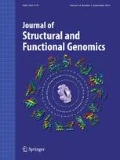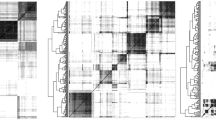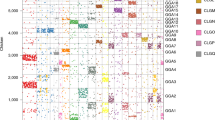Abstract
The appearance of the vertebrates demarcates some of the most far-reaching changes of structure and function seen during the evolution of the metazoans. These drastic changes of body plan and expansion of the central nervous system among other organs coincide with increased gene numbers. The presence of several groups of paralogous chromosomal regions in the human genome is a reflection of this increase. The simplest explanation for the existence of these paralogies would be two genome doublings with subsequent silencing of many genes. It is argued that gene localization data and the delineation of paralogous chromosomal regions give more reliable information about these types of events than dendrograms of gene families as gene relationships are often obscured by uneven replacement rates as well as other factors. Furthermore, the topographical relations of some paralogy groups are discussed.
Similar content being viewed by others
References
Adams, M.D., et al. (2000) The genome sequence of Drosophila melanogaster. Science, 287, 2185-2195.
Bork, P. and Copley, R. (2001) Filling in the gaps. Nature, 409, 818-820.
Burt, D.W., Bruley, C., Dunn, I.C., Jones, C.T., Ramage, A., Law, A.S., Morrice, D.R., Paton, I.R., Smith, J., Windsor, D., Sazanov, A., Fries, R. and Waddington, D. (1999) The dynamics of chromosome evolution in birds and mammals. Nature, 402, 411-413.
Chaudhary, R., Raudsepp, T., Guan, X.-Y., Zhang, H. and Chowdhary, B.P. (1998) Zoo-FISH with microdissected arm specific paints for HSA2, 5, 6, 16, and 19 refines known homology with pig and horse chromosomes. Mamm. Genome, 9, 44-49.
Chowdhary, B.P., Frönicke, L., Gustavsson, I. and Scherthan, H. (1996) Comparative analysis of the cattle and human genomes: Detection of ZOO-FISH and gene mapping-based chromosomal homologies. Mamm. Genome, 7, 297-302.
Chowdhary, B.P., Raudsepp, T., Frönicke, L. and Scherthan, H. (1998) Emerging patterns of comparative genome organization in some mammalian species as revealed by zoo-FISH. Genome Res., 8,pp577-589.
Ferrier, D.E.K., Minguillón, C., Holland, P.W.H. and Garcia-Fernández, J. (2000) The amphioxus Hox cluster: deuterostome posterior flexibility and Hox14. Evol. Dev., 2, 284-293.
Frönicke, L., Chowdhary, B.P., Scherthan, H. and Gustavsson, I. (1996) A comparative map of the porcine and human genomes demonstrates ZOO-FISH and gene mapping-based chromosomal homologies. Mamm. Genome, 7, 285-290.
Gibson, T.J. and Spring, J. (2000) Evidence in favour of ancient octaploidy in the vertebrate genome. Biochem. Soc. Trans., 28, 259-264.
Hallböök, F., Kullander, K. and Lundin, L.-G. (2001) Evolution of the neurotrophins and their receptors. In Neurobiology of the Neurotrophins (Ed. Mocchetti, I.), FP Graham Publishing Co, Johnson City, TN, pp. 65-100.
Holland, P.W.H. (1997) Vertebrate evolution: Something fishy about Hox genes. Curr. Biol., 7, R570-R572.
Holland, P.W.H., Garcia-Fernández, J., Williams, N.A. and Sidow, A. (1994) Gene duplications and the origins of vertebrate development. Development Suppl., 125?133.
Hughes, A.L. (1999) Phylogenies of developmentally important proteins do not support the hypothesis of two rounds of genome duplication early in vertebrate history. J. Mol. Evol., 48, 565-576.
Iwabe, N., Kuma, K. and Miyata, T. (1996) Evolution of gene families and relationship with organismal evolution: Rapid divergence of tissue-specific genes in the early evolution of chordates. Mol. Biol. Evol., 13, 483-493.
Kasahara, M., Hayashi, M., Tanaka, K., et al. (1996) Chromosomal localization of the proteasome Z subunit gene reveals an ancient chromosomal duplication involving the major histocompatibility complex. Proc. Natl. Acad. Sci. USA, 93, 9096-9101.
Katsanis, N., Fitzgibbon, J. and Fisher, E.M.C. (1996) Paralogy mapping: Identification of a region in the human MHC triplicated onto human chromosomes 1 and 9 allows the prediction and isolation of novel PBX and NOTCH loci. Genomics, 35, 101-108.
Li, W.-H. (1997) Molecular Evolution. Sinauer Associates, Sunderland, MA.
Lundin, L.-G. (1989) Gene homologies and the nerve system. In Genetics of Neuropsychiatric Diseases (Ed. Wetterberg, L.), Vol. 51, MacMillan Press, London, pp. 43-58.
Lundin, L.-G. (1993) Evolution of the vertebrate genome as reflected in paralogous chromosomal regions in man and the house mouse. Genomics, 16, 1-19.
Lundin, L.-G. (1999) Gene duplications in early metazoan evolution. Sem. Cell Dev. Biol., 10, 523-530.
Martin, A. (2001) Is tetralogy true? Lack of support for the 'one to-four rule'. Mol. Biol. Evol., 18, 89-93.
Meyer, A. and Schartl, M. (1999) Gene and genome duplications in vertebrates: the one-to-four (-to-eight in fish) rule and the evolution of novel gene functions. Curr. Opin. Cell Biol., 11, 699-704.
Nadeau, J.H. and Sankoff, D. (1997) Comparable rates of gene loss and functional divergence after genome duplications early in vertebrate evolution. Genetics, 147, 1259-1266.
Nadeau, J.H. and Sankoff, D. (1998) Counting on comparative maps. Trends Genet., 14, 495-501.
O'Brien, S. J., Wienberg, J. and Lyons, L.A. (1997) Comparative genomics: lessons from cats. Trends Genet., 13, 393-99.
Ohno, S. (1969) The role of gene duplication in vertebrate evolution. In The Biological Basis of Medicine (Eds., Bittar, E.D. and Bittar, N.), Vol. 4, Academic Press, London, pp. 109-132.
Ohno, S. (1970) Evolution by Gene Duplication, Springer-Verlag, Berlin.
Ohno, S. (1998) The notion of the Cambrian pananimalia genome and a genomic difference that separated vertebrates from invertebrates. In Progress in Molecular and Subcellular Biology (Ed., Müller, W.E.G.), Vol. 21, Springer-Verlag, Berlin, pp. 97-117.
Ohno, S., Wolf, U. and Atkin, N.B. (1968) Evolution from fish to mammals by gene duplication. Hereditas, 59, 169-187.
Ono, K., Suga, H., Iwabe, N., Kuma, K. and Miyata, T. (1999) Multiple protein tyrosine phosphatases in sponges and explosive gene duplication in the early evolution of animals before the parazoan-eumetazoan split. J. Mol. Evol., 48, 654-662.
Page, R.D.M. and Charleston, M.A. (1997) From gene to organismal phylogeny: Reconciled trees and the gene tree/species tree problem. Mol. Phylogenet. Evol., 7, 231-240.
Patton, S.J., Luke, G.N. and Holland, P.W.H. (1998) Complex history of a chromosomal paralogy region: insights from Amphioxus aromatic amino acid hydroxylase genes and insulinrelated genes. Mol. Biol. Evol., 15, 1373-1380.
Pebusque, M.J., Coulier, F., Birnbaum, D. and Pontarotti, P. (1998) Ancient large-scale genome duplications: phylogenetic and linkage analyses shed light on chordate genome evolution. Mol. Biol. Evol., 15, 1145-1159.
Pollard, S.L. and Holland, P.W.H. (2000) Evidence for 14 homeobox gene clusters in human genome ancestry. Curr. Biol., 10, 1059-1062.
Popovici, C., Leveugle, M., Birnbaum, D. and Coulier, F. (2001) Homeobox gene clusters and the human paralogy map. FEBS Lett., 491, 237-242.
Postlethwait, J.H., Woods, I.G., Ngo-Hazelett, P., Yan, Y.-L., Kelly, P.D., Chu, F., Huang, H., Hill-Force, A. and Talbot, W.S. (2000) Zebrafish comparative genomics and the origins of vertebrate chromosomes. Genome Res., 10, 1890-1902.
Raudsepp, T., Frönicke, L., Scherthan, H., Gustavsson, I. and Chowdhary, B.P. (1996) ZOO-FISH delineates conserved chromosomal segments in horse and man. Chromosome Res., 4, 218-225.
Scherthan, H., Cremer, T., Arnason, U., Weier, H.-U., Lima-de-Faria, A. and Frönicke, L. (1994) Comparative chromosome painting discloses homologous segments in distantly related mammals. Nature Genet., 6, 342-347.
Searle, A.G. and Selley, R.L. (1997) Tables of genetic homology. Mouse Genome, 95, 106-160.
Sharman, A.C. and Holland, P.W.H. (1996) Conservation, duplication, and divergence of developmental genes during chordate evolution. Netherlands J. Zool., 46, 47-67.
Shimeld, S.M. and Holland, P.W.H. (2000) Vertebrate innovations. Proc. Natl. Acad. Sci. USA, 97, 4449-4452.
Sidow, A. (1996) Gen(om)e duplications in the evolution of early vertebrates. Curr. Opin. Genet. Dev., 6, 715-22.
Simmen, M.W., Leitgeb, S., Clark, V.H., Jones, S. J. M. and Bird, A. (1998) Gene number in an invertebrate chordate, Ciona intestinalis. Proc. Natl. Acad. Sci. USA, 95, 4437-4440.
Skrabanek, L. and Wolfe, K.H. (1998) Eukaryote genome duplication-where's the evidence? Curr. Opin. Genet. Dev., 8, 694-700.
Smith, N.G.C., Knight, R. and Hurst, L.D. (1999) Vertebrate genome evolution: a slow shuffle or a big bang? BioEssays, 21, 697-703.
Spring, J. (1997) Vertebrate evolution by interspecific hybridisation-are we polyploid? FEBS Lett., 400, 2-8.
Spring, J., Goldberger, O.A., Jenkins, N.A., Gilbert, D.J., Copeland, N.G. and Bernfield, M. (1994) Mapping of the syndecan genes in the mouse: Linkage with members of the Myc gene family. Genomics, 21, 597-601.
Suga, H., Hoshiyama, D., Kuraku, S., Katoh, K., Kubokawa, K. and Miyata, T. (1999a) Protein tyrosine kinase cDNAs from Amphioxus, hagfish, and lamprey: Isoform duplications around the divergence of cyclostomes and gnathostomes. J. Mol. Evol., 49, 601-608.
Suga, H., Koyanagi, M., Hoshiyama, D., Ono, K., Iwabe, N., Kuma, K. and Miyata, T. (1999b) Extensive gene duplication in the early evolution of animals before the parazoan-eumetazoan split demonstrated by G proteins and protein tyrosine kinases from sponge and Hydra. J. Mol. Evol., 48, 646-653.
Suga, H., Ono, K. and Miyata, T. (1999c) Multiple TGF-beta receptor related genes in sponge and ancient gene duplications before the parazoan-eumetazoan split. FEBS Lett., 453, 346-350.
Wagner, A. (1998) The fate of duplicated genes: loss or new function? BioEssays, 20, 785-788.
Wang, Y. and Gu, X. (2000) Evolutionary patterns of gene families generated in the early stage of vertebrates. J. Mol. Evol., 51, 88-96.
Wolfe, K.H. and Shields, D.C. (1997) Molecular evidence for an ancient duplication of the entire yeast genome. Nature, 387, 708-713.
Wraith, A., Törnsten, A., Chardon, P., Harbitz, I., Chowdhary, B.P., Andersson, L., Lundin, L.-G. and Larhammar, D. (2000) Evolution of the neuropeptide Y receptor family: Gene and chromosome duplications deduced from the cloning and mapping of the five receptor subtype genes in pig. Genome Res., 10, 302-310.
Author information
Authors and Affiliations
Corresponding author
Rights and permissions
About this article
Cite this article
Lundin, LG., Larhammar, D. & Hallböök, F. Numerous groups of chromosomal regional paralogies strongly indicate two genome doublings at the root of the vertebrates. J Struct Func Genom 3, 53–63 (2003). https://doi.org/10.1023/A:1022600813840
Issue Date:
DOI: https://doi.org/10.1023/A:1022600813840




